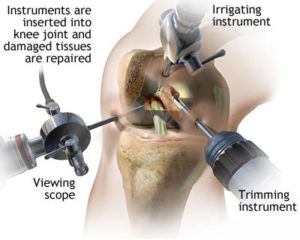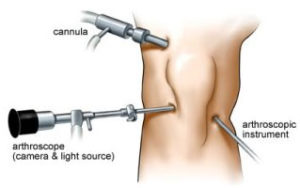
Arthroscopy (also called arthroscopic surgery) is a minimally invasive surgical procedure on a joint in which an examination and sometimes treatment of damage is performed using an arthroscope, an endoscope that is inserted into the joint through a small incision. Arthroscopic procedures can be performed to evaluate or treat many orthopaedic conditions including torn cartilage (known by doctors as “meniscus”), torn surface (articular) cartilage, ACL reconstruction, and trimming damaged cartilage.
Get best
for less post – operative pain and scarring along with shorter recovery time at Jyoti Nursing Home.
The advantage over traditional open surgery is that the joint does not have to be opened up fully. For knee arthroscopy only two small incisions are made, one for the arthroscope and one for the surgical instruments to be used in the knee cavity. This reduces recovery time and may increase the rate of success due to less trauma to the connective tissue. It is especially useful for professional athletes, who frequently injure knee joints and require fast healing time. There is also less scarring, because of the smaller incisions. Irrigation fluid is used to distend the joint and make a surgical space. Sometimes this fluid leaks (extravasates) into the surrounding soft tissue, causing edema.
The surgical instruments are smaller than traditional instruments. Surgeons view the joint area on a video monitor, and can diagnose and repair torn joint tissue, such as ligaments and menisci or cartilage.
It is technically possible to do an arthroscopic examination of almost every joint, most commonly the knee, shoulder, elbow, wrist, ankle, foot, and hip.

Through a small incision arthroscope can be inserted in the joint, which help to visualize inside the joint on the monitor via camera attached to the arthroscope.
Due to injury, when Anterior or posterior cruciate ligament is torn, knee becomes unstable. Arthroscopically these ligaments can be reconstructed. Arthroscopy is a common surgical procedure in which a joint (arthro-) is viewed (-scopy) using a small camera. Arthroscopy gives doctors a clear view of the inside of the knee. This helps them diagnose and treat knee problems.
Technical advances have led to high definition monitors and high resolution cameras
These and other improvements have made arthroscopy a very effective tool for treating knee problems. According to the American Orthopaedic Society for Sports Medicine, more than 4 million knee arthroscopies are performed worldwide each year.
Hip arthroscopy refers to the viewing of the interior of the acetabulofemoral (hip) joint through an arthroscope and the treatment of hip pathology through a minimally invasive approach. This technique is sometimes used to help in the treatment of various joint disorders has gained popularity because of the small incisions used and shorter recovery times when compared with conventional surgical techniques (sometimes referred to as “open surgery”). Hip arthroscopy was not feasible until recently, new technology in both the tools used and the ability to distract the hip joint has led to a recent surge in the ability to do hip arthroscopy and the popularity of it.
Shoulder arthros copy is surgery that uses a tiny camera called an arthroscope to examine or repair the tissues inside or around your shoulder joint. The arthroscope is inserted through a small incision (cut) in your skin.
Description:- The rotator cuff is a group of muscles and tendons that cover your shoulder joint. These muscles and tendons hold your arm in your ball and socket shoulder joint, and they help you move your shoulder in different directions. The tendons in the rotator cuff can tear when they are overused or injured.
Most people receive general anesthesia before this surgery. This means you will be unconscious and unable to feel pain. Or, you may have regional anesthesia. Your arm and shoulder area will be numbed so that you do not feel any pain in this area. If you receive regional anesthesia, you will also be given medicine to make you very sleepy during the operation.
Arthroscopy may be recommended for these shoulder problems:
In recent years, the elbow is among the small joints that have been explored arthroscopically, with gradual development of safe and effective diagnostic and surgical techniques. The elbow is easily accessed for arthroscopic examination and standard portals have been described. Elbow arthroscopy requires detailed knowledge of the anatomy and the ability to introduce instruments through deep muscle layers in narrow confines near crucial neurovascular structures. With this knowledge and ability, the surgeon should see the benefits of minimal dissection and a more rapid rehabilitation Arthroscopy is a procedure that orthopaedic surgeons use to inspect, diagnose, and repair problems inside a joint. The word arthroscopy comes from two Greek words, “arthro” (joint) and “skopein” (to look). The term literally means “to look within the joint.” During elbow arthroscopy, your surgeon inserts a small camera, called an arthroscope, into your elbow joint. The camera displays pictures on a television screen, and your surgeon uses these images to guide miniature surgical instruments. Because the arthroscope and surgical instruments are thin, your surgeon can use very small incisions (cuts), rather than the larger incision needed for open surgery. This results in less pain for patients, less joint stiffness, and often shortens the time it takes to recover and return to favorite activities.